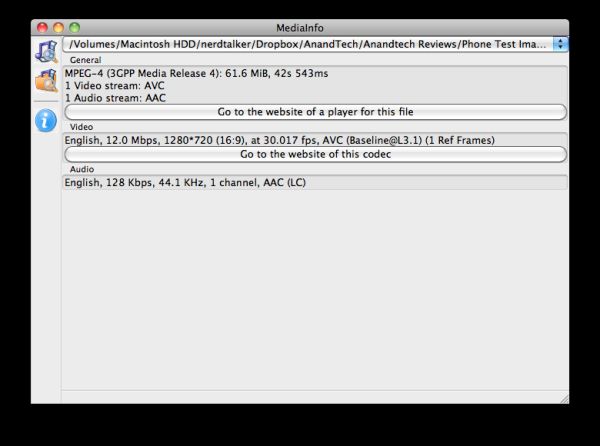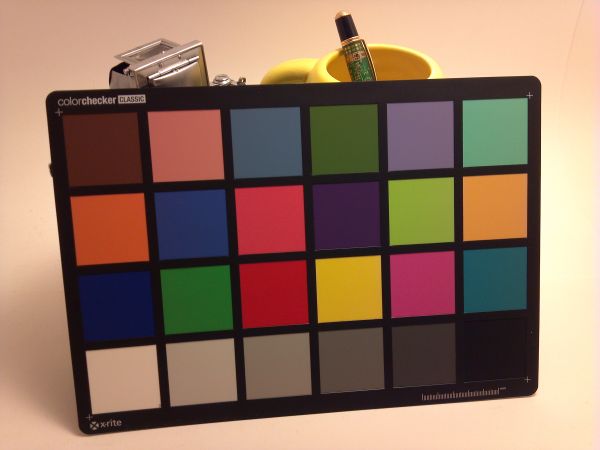Motorola Droid X2 Review - A Droid X with Tegra 2
by Brian Klug on July 7, 2011 8:31 AM ESTCamera - Upgraded
Captured image quality is getting better with time, thanks to both improved image signal processing (ISP), software, optics, and of course sensors. Thankfully the X2 brings the entire package of improvements to the table. First off, the most obvious difference is that the mechanical shutter is gone (whose purpose I never quite understood), and the first vertex of the camera seems to have a larger diameter, meaning it has improved light collection over the X.
The original X was one of the first smartphones we tested with 720p video capture after the iPhone 4 made its debut. At that time, the X captured 720p24 8 Mbps MPEG-4 video with 1 channel 96 Kbps AAC audio. The X2 bumps video capture up to 720p30 H.264 at 12 Mbps with 128 Kbps single channel AAC audio.
Obviously the Tegra 2 SoC inside the Droid X2 could capture at 1080p, but we’d honestly rather see high quality 720p like the X2 shoots over lower bitrate 1080p. Honestly, 1080p still remains a checkbox feature today until bitrates get higher or encoders get better.
I initially noticed a serious problem with video capture on the X2. Set to capture to the external SD card (by default), video had second long dropouts and stalls, like this. Around 12 and 19 seconds, the fun starts:
On the device itself, capture would correspondingly pause, hang, and even crashed once. I shot two or three videos to confirm to myself that it wasn’t just a fluke, and also closed every application to see if RAM consumption was a problem. After some googling and discovering similar complaints on forums, I stumbled on the problem - set the capture destination to internal storage, and the stuttering goes away. I went and re-captured the video, and boom, no stuttering:
What’s curious about the whole thing is that the card shouldn’t be the problem. I tested the 8 GB class 4 microSD card inside the X2 (which comes preinstalled) in a new USB 3.0 Lexar card reader with CrystalDiskMark and found that it had sequential writes of just over 5 MB/s. Far more than the 1.5 MB/s which would be required for the X2’s 720p video + audio stream. Testing with a 32 GB class 2 resulted in no stuttering, and after a format the supplied microSD card went back to not stuttering. Either way, if you experience problems, switch to internal storage, format the external, or get another microSD card.
The X2 includes an 8 MP camera with dual LED flash, just like the previous X. However, there’s more to image quality than just MP numbers, which would have you thinking that everything is the same.
Still image quality on the X2 is improved from the original Droid X. In some ways it’s considerably better, others the same.
White balance in our lighbox test is a bit warm, as are a few outdoors test shots. There’s some chromatic aberration at the extreme angles in the lightbox test as well, evidenced by the red circle around the image. That said overall sharpness seems better.
What I miss from the Droid X is that camera button, which (as I mention in the video review) Motorola seriously emphasized the first time around as a distinguishing feature for the X. The problem isn't so much that it's gone as it is that the camera software now relies on an awkwardly placed software capture button. What I mean is that the X2 uses the exact same camera UI as the original X, which obviously was tailored around using the shutter button instead of the software shutter button. As a result, more often than not I would press near (but not on) the button and just toggle the OSD instead of taking a photo.






































72 Comments
View All Comments
NeoteriX - Thursday, July 7, 2011 - link
Again, the N8 is an unfair comparison, it's not even the same class of camera phone. Just like the other examples I cited, the Sony C-902, Nokia N82... these are cameras that happen to also be phones. The problem is that these are not apples to apples comparisons.The sensor on the N8 is 1/1.83″ -- by way of comparison, the Canon S95, a real point and shoot camera with very well-respected low light performance relative to its peers has only a slightly larger sensor of 1/1.7" Not to mention it has carl zeiss branded optics and a xenon flash (like the other examples I cited)
The iPhone 4 uses a mobile camera sensor of 1/3.2" and so does the HTC sensation.
Now I'm all for big sensors in cameraphones--the better the image quality the better, as the best camera is ultimately the one you take with you. And the N8 shows that you can shove real point and shoot sensors into a phone, but let's face the reality -- the market of phones with REAL camera sensors and optics is a very, very, very small niche market (they cost $$$ to put in those sensors) and doesn't reflect the mass market of advanced smartphones.
Again, the iPhone 4 represents the best candidate of this balance, and I'm really hoping others HTC, Motorola, etc. step up their game here, but I don't plan on owning an Apple device in the near future.
munky - Thursday, July 7, 2011 - link
It's a valid comparison, the N8 is a smartphone like all the others you mentioned, in the same form factor. I'm not comparing something the size of a DSLR to something that fits in your pocket.Yes, it has a bigger sensor, just like the S95 has a bigger sensor than average pocket cameras - does that mean the S95 is not qualified to be the gold standard of pocket cameras? Doing so is just a refusal to acknowledge a superior product in favor of the lowest common denominator.
NeoteriX - Thursday, July 7, 2011 - link
I agree, but I think the distinguishing factor is that the S95 performs better than anything in its class by any dimension.The large sensor camera phones are still a "niche" in the sense that you have to singularly want exceptional photographic performance to buy one of these phones -- and in return, you have to make several compromises as to the user interface, CPU performance/technology, software ecosystem, etc. The phones are geared towards an audience willing to deal with that.
However, if you look at the other major powers in the phone OS ecosystems (iOS, Win7, Android, WebOS?), none incorporate the large sensor into any phone, much less the kind of flagship phone that you would expect them to pull all the stops out for.
Believe me when I say I would go out and immediately buy the first Android phone with all the furnishings -- dualcore CPU, etc. that *also* included a large sensor and quality glass.
Exodite - Thursday, July 7, 2011 - link
That's a bit of a red herring considering that the vast majority of these so-called 'camera phones' aren't lacking in other desirable features.Indeed, a good camera is becoming something of a hallmark of high-end smartphones in general, HTC being the exception to the rule.
As for the cost you mentioned before, the N8 - undeniably the best-equipped smartphone today when the camera is concerned - is a mid-range phone.
Brian Klug - Thursday, July 7, 2011 - link
I'm a huge optics nerd (it's what I studied in college at least) so I always try and find out everything I can about the cameras in here. Usually that ends up being very little because it either isn't documented, or there's no information in the place I look.For the sensor type, it's easy enough to just run dmesg and scan through there. HTC lately has been initializing the camera and leaving the part number right there. I searched through on the X2 and couldn't find any camera sensor part numbers even in the sections where they're clearly starting to init the camera. It's unfortunate, because otherwise we could get a better feel for what sensors are usually very good and which ones usually aren't.
It's interesting that Apple did such a good job marketing backside illumination with the iPhone 4, when essentially every sensor at or over 8 MP needs to be backside illuminated (and thinned) due to skew effects. That said their camera is indeed very good.
-Brian
jamyryals - Thursday, July 7, 2011 - link
Love the video review format. My favorite smart phone reviewer on the net, keep it up Brian.munky - Thursday, July 7, 2011 - link
Why do the graphs always compare the usual Samsung and Motorolla phones, the old practically irrelevant iphone 3gs, Nexus One and Dell Streak, but not more variety of modern phones, like the Nokia N8, for example? Instead of grouping tablets and phones in the same graphs, separate the two categories so that each one has a better selection of relevant entries.Exodite - Thursday, July 7, 2011 - link
Regarding Motorala and their use of FWVGA over WVGA, they're not the only Android handset manufacturer who went that route as Sony-Ericsson also uses FWVGA on the X10/arc/neo/play.BryanC - Thursday, July 7, 2011 - link
I might consider buying this phone if not for the terrible pentile screen door effect, which is simply unacceptable in today's day and age.The iPhone4 has 960x640x3 subpixels in 5.65in2 area. The Droid X2 has 960x540x2 subpixels in 7.90in2 area. The iPhone has 2.5X the subpixel density of the Droid X2! And it's immediately obvious when you look at the displays - the iPhone4 display is so detailed the image looks printed on, it's in a completely different class.
Too bad.
JayQ330 - Thursday, September 1, 2011 - link
what does that have to do with any of this? oh i see, wipe your chin there's still some iphone honey left.